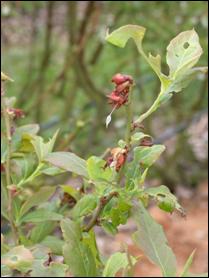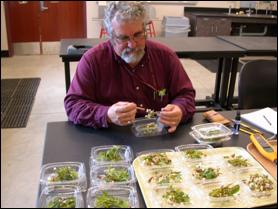Washington State University
Mount Vernon Northwestern Research and Extension Center
Mount Vernon, WA 98273-4768
Winter moth, Operophtera brumata (L.)
A population of late instar winter moth were collected on 20 May from a varietal blueberry planting at the WSU Mount Vernon NWREC. The population was an economic one (Fig. 1). These larvae had moved from the floral buds and were voraciously feeding and spinning silken thread to tie leaves together. If not controlled, winter moth larvae are capable of severely defoliating blueberry before they drop to the ground to pupate under debris. Infested terminals 3-4 inches long were collected and placed in paper bags and held in a refrigerator before being treated with aqueous suspensions of insecticides with a hand held atomizer until dripping. Five terminal replicates were place in quart sized, clear plastic, disposable food containers (Fig. 2).
These larvae had moved from the floral buds and were voraciously feeding and spinning silken thread to tie leaves together. If not controlled, winter moth larvae are capable of severely defoliating blueberry before they drop to the ground to pupate under debris. Infested terminals 3-4 inches long were collected and placed in paper bags and held in a refrigerator before being treated with aqueous suspensions of insecticides with a hand held atomizer until dripping. Five terminal replicates were place in quart sized, clear plastic, disposable food containers (Fig. 2). The lids were each puncture multiple times with a sharp needle probe for ventilation. Bayer CropScience’s flubendiamide (Belt™) is a new lepidopteran-specific insecticide that is active via ingestion with no contact activity. DuPont’s experimental DPX-HGW86 (Cyazypyr™) is formulated as a SE (suspo emulsion) or OP (oil dispersion). It is translaminar via foliar application and systemic via root uptake (drip irrigation application) and broad spectrum. Belt and Cyazypyr are members of a new chemical class (IRAC) called diamides that modulate ryanodine receptors in muscles cells causing uncontrolled release and depletion of Ca2+.
The lids were each puncture multiple times with a sharp needle probe for ventilation. Bayer CropScience’s flubendiamide (Belt™) is a new lepidopteran-specific insecticide that is active via ingestion with no contact activity. DuPont’s experimental DPX-HGW86 (Cyazypyr™) is formulated as a SE (suspo emulsion) or OP (oil dispersion). It is translaminar via foliar application and systemic via root uptake (drip irrigation application) and broad spectrum. Belt and Cyazypyr are members of a new chemical class (IRAC) called diamides that modulate ryanodine receptors in muscles cells causing uncontrolled release and depletion of Ca2+.
By 2 DAT all treatments were significantly similar to the standard Success with larval mortality for mature larval instars ranging between 83% to 97% (Table 1). Though not significant, the high rate of HGW86, the oil dispersion formulation and low rate + MSO provided 100% mortality by 7 DAT. There appeared to be some performance differences for Belt when mixed with two different surfactants but by 7 DAT they were similar to HGWW86 and Success.
| Treatment | Rate/acre | Percent Mortality | ||
|---|---|---|---|---|
| 1 DAT | 2 DAT | 7 DAT | ||
| Mean within columns followed by the same letter are not significantly different (Fisher’s protected LSD, P<0.05), PRC ANOVA SAS. | ||||
| 1MSO (methylated seed oil adjuvant, NIS (non-ionic surfactant), OS (organosilicone). | ||||
| *Buffer to a pH of 5.0 or lower. | ||||
| HGW86 10SE* | 13.6 fl oz | 80.0a | 86.7a | 93.3a |
| HGW86 10SE* | 20.6 fl oz | 93.3a | 96.7a | 100a |
| HGW86 10SE + MSO1,* | 13.5 fl oz | 83.3a | 93.3a | 100a |
| HGW86 OD* | 13.5 fl oz | 76.7a | 83.3a | 100a |
| Belt + NIS1 | 4 fl oz | 96.7a | 96.7a | 96.7a |
| Belt + OS1 | 4 fl oz | 80.0a | 90.0a | 100a |
| Success | 6 fl oz | 96.7a | 96.7a | 100a |
| Untreated Check | 0 | 0 | 6.7b | 20b |